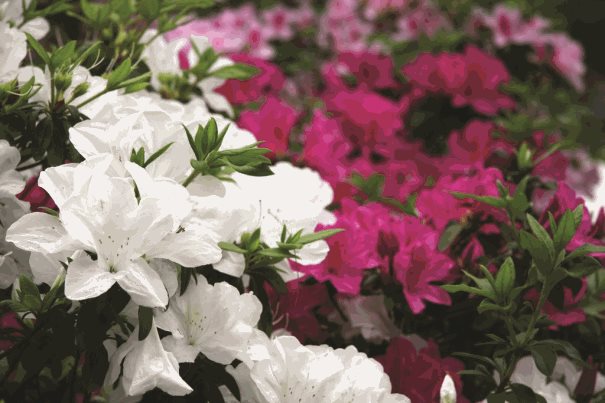
Azaleas (botanically Rhododendron) are the most popular flowering shrubs in this part of the country.
Exposure
Azaleas prefer cool, partially-shaded sites, such as the filtered shade of pine trees (when planted beneath hardwood trees, their shallower roots must compete for nutrients and water.) Althoughsome varieties tolerate sun better than others, all azaleas prefer an area that is not exposed to long periods of hot sun and drying winds. Azaleas planted in full sun are more susceptible to lace bugs, a common azalea pest, and early morning sun, following a hard freeze, may cause cold injury. Flowers last longer if plants are partially shaded, but heavy shade may result in poor flowering and weak growth.
Soil
Azaleas grow best in acid (pH of 4.5 to 6.0), well-drained, organic-rich soil. Before planting, have the soil tested, and adjust the pH according the test results. Azaleas are shallow-rooted plants, easily damaged by excessive soil moisture. Poorly drained sites do not receive the oxygen required for healthy growth, and may lead to root rot diseases. Amend the soil in these areas with composted pine bark, and plant the root ball higher than the surrounding ground level.
Mulching
A 2- to 3-inch layer of organic mulch is very important. It conserves soil moisture, maintains soil temperature, and helps to discourage weeds. There are many suitable materials available for mulching azaleas. Pine straw, composted pine bark, and leaves all work very well, enriching the soil with organic matter as they decompose. Keep the mulch a couple of inches away from the main stem of the plant, to keep the bark dry, and extend the area mulched beyond the outermost branches of the plant.
Watering
Azaleas are shallow-rooted plants, and require irrigation during dry periods. This is especially true when planting in the spring. Azaleas planted in warm weather and in sandy soils may require watering of the root mass twice a week during the first year.
To determine when to water, pull back a small area of mulch near the base of the plant, and check the moisture level of the root ball and of the surrounding soil. If the top few inches of soil feels dry, wet the soil deeply, to a depth of at least 6 to 8 inches. Use soaker hoses or drip irrigation to slowly water the base of the plants. Overhead irrigation may promote disease, as will waterlogged soil. It is important to reach a balance of regular, deep waterings, and good drainage, to maintain a healthy plant.
Fertilizing
Azaleas have low nutritional requirements, compared to other shrubs. A soil that is amended with organic matter prior to planting, and followed by a mulch of compost, shredded leaves, pine straw, or other organic material, will usually provide sufficient nutrients for healthy growth.
Fertilizer should only be used to correct a nutrient deficiency or increase growth rate. A nutrient deficiency will exhibit a number of symptoms, including stunted growth, small than normal leaves, light green to yellowish leaf color, and early leaf drop. Be aware that these same symptoms can be caused by other problems, such as heavily compacted soil, stress from insects, disease, or weeds, and excessively wet or dry soil. Fertilizer will not correct these problems, so it is important to diagnose the cause of the symptoms, and treat accordingly. If needed, fertilize in the spring, after the plants have finished flowering. You can use an organic fertilizer, such as Holly-tone or Plant-tone, following the directions on the label. It is recommended to have a soil test in order to determine if fertilizer will benefit your azaleas.
Need Help Getting Started? Visit Us for Expert Advice and Supplies!
With 17 locations across 3 states Meadows Farms is close by and happy to help. Our expert team will walk you through options and help with project planning. Visit us to view our selection and get started today.

